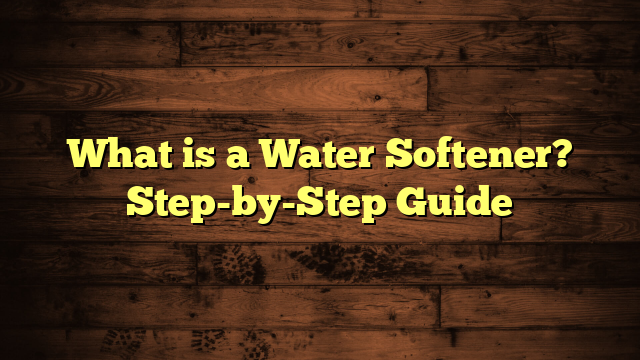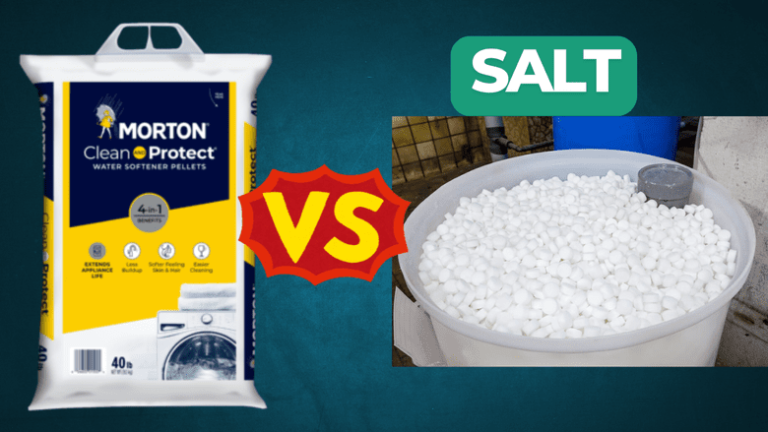What is a Water Softener? Step-by-Step Guide
Understanding water softeners is essential for maintaining the quality of your water supply and protecting your household appliances. This comprehensive guide will walk you through everything you need to know about water softeners, from their basic function to installation and maintenance.
What is a Water Softener?
A water softener is a household appliance designed to remove minerals that cause water hardness, primarily calcium and magnesium ions. Hard water can lead to scale buildup in pipes and appliances, reducing their efficiency and lifespan. By softening water, these devices help maintain plumbing systems, enhance the effectiveness of soaps and detergents, and improve the overall quality of water used for bathing, cleaning, and drinking.
Importance of Water Softening
Hard water is a common issue in many regions, leading to various problems such as:
- Scale Buildup: Accumulation of mineral deposits in pipes and appliances.
- Reduced Efficiency: Appliances like water heaters and washing machines work harder, increasing energy consumption.
- Skin and Hair Issues: Hard water can cause dryness and irritation.
- Laundry Problems: Clothes may feel stiff and appear dull.
Investing in a water softener can mitigate these issues, ensuring a more comfortable and cost-effective household environment.
How Water Softeners Work?
At the heart of most water softeners is the ion exchange process. This method involves replacing hardness-causing minerals with sodium or potassium ions. When hard water passes through the softener, resin beads coated with sodium ions attract and hold onto the calcium and magnesium ions, effectively removing them from the water supply.
Resin Beads and Regeneration
Resin beads are the key component in water softeners. These tiny beads are charged with sodium ions and act as a magnet for hardness minerals. Over time, the resin becomes saturated with calcium and magnesium ions, requiring regeneration. During regeneration, a salt solution flushes the resin, replenishing the sodium ions and washing away the accumulated minerals.
Ion Exchange Process Overview
| Step | Description |
|---|---|
| 1. Water Entry | Hard water enters the softener system. |
| 2. Ion Exchange | Resin beads exchange sodium ions for hardness ions. |
| 3. Soft Water Output | Softened water flows to household faucets. |
| 4. Regeneration | Salt solution cleans and recharges resin beads. |
Types of Water Softeners
Salt-Based Water Softeners
Salt-based softeners are the most common type, utilizing the ion exchange process described above. They require regular addition of salt (sodium chloride) to maintain their effectiveness. These systems are highly effective at removing hardness minerals and are suitable for households with significant water hardness issues.
Salt-Free Water Softeners
Salt-free systems, also known as water conditioners, do not remove hardness minerals but instead alter their structure to prevent scale buildup. These systems are ideal for those who prefer a more environmentally friendly option and want to avoid the maintenance associated with salt-based systems. However, they may not be as effective in extremely hard water conditions.
Comparison of Water Softener Types
| Feature | Salt-Based Softeners | Salt-Free Softeners |
|---|---|---|
| Mechanism | Ion exchange | Template-assisted crystallization |
| Maintenance | Regular salt replenishment | Minimal maintenance |
| Effectiveness | Highly effective | Moderately effective |
| Environmental Impact | Higher (salt usage) | Lower (no salt required) |
| Best For | High hardness areas | Mild to moderate hardness |
Benefits of Using a Water Softener
Preventing Scale Build-Up
One of the primary benefits of a water softener is its ability to prevent scale buildup in plumbing systems and appliances. Scale can clog pipes, reduce water flow, and cause overheating in water heaters, leading to inefficiency and potential damage.
Extending Appliance Lifespan
By eliminating hardness minerals, water softeners help extend the lifespan of household appliances such as dishwashers, washing machines, and water heaters. Softened water reduces the strain on these appliances, decreasing the likelihood of malfunctions and costly repairs.
Enhancing Cleaning Efficiency
Soft water enhances the effectiveness of soaps and detergents, resulting in cleaner dishes, laundry, and surfaces. It also reduces the need for excessive soap usage, leading to cost savings over time.
Choosing the Right Water Softener
Assessing Water Hardness
Before selecting a water softener, it’s essential to determine the hardness level of your water. This can be done using a home test kit or by consulting your local water utility provider. Understanding your water’s hardness will help you choose a system with the appropriate capacity and features.
System Capacity and Size
Water softeners come in various sizes and capacities, measured in grains per gallon (gpg). The capacity should match your household’s water usage and hardness level to ensure optimal performance. A system that is too small may not effectively soften all the water, while an oversized system can lead to unnecessary expenses.
Selecting Water Softener Capacity
| Household Size | Daily Water Usage (gallons) | Recommended Capacity (grains/day) |
|---|---|---|
| 1-2 people | 50-100 | 24,000 |
| 3-4 people | 100-150 | 30,000 |
| 5-6 people | 150-200 | 36,000 |
| 7+ people | 200+ | 42,000+ |
Additional Features to Consider
Modern water softeners offer various features to enhance functionality and convenience, such as:
- Digital Controls: Allow for easy programming and monitoring.
- Efficiency Settings: Optimize salt and water usage.
- Backwash Indicators: Alert when maintenance is needed.
- Bypass Valves: Enable maintenance without disrupting water supply.
Step-by-Step Installation Guide
Preparation and Tools Needed
Before beginning installation, gather the necessary tools and materials:
- Water softener unit
- Pipe wrenches
- Teflon tape
- Tubing cutters
- Plumber’s tape
- Bucket and towels
Installation Steps
- Choose the Location: Select a suitable spot near the main water supply, preferably in a basement or utility area.
- Turn Off Water Supply: Shut off the main water valve and drain the system.
- Connect the Inlet and Outlet: Use Teflon tape on threaded connections to ensure a watertight seal. Attach the inlet and outlet pipes to the water softener.
- Install the Bypass Valve: This allows you to bypass the softener during maintenance.
- Connect to the Drain and Power: Ensure the drain hose is securely connected and the unit is plugged into an electrical outlet.
- Add Salt: Fill the brine tank with the recommended type of salt.
- Program the Unit: Follow the manufacturer’s instructions to set the regeneration cycle and hardness level.
Testing the System
After installation, turn the water supply back on and check for leaks. Run a softener cycle to ensure the system is functioning correctly. Test the water hardness to confirm that the water softener is effectively removing minerals.
Maintaining Your Water Softener
Regular Maintenance Tasks
Proper maintenance ensures the longevity and efficiency of your water softener:
- Salt Level Checks: Regularly check and replenish salt in the brine tank.
- Cleaning the Brine Tank: Periodically clean to prevent salt bridges and buildup.
- Resin Bead Replacement: Replace resin beads as recommended by the manufacturer.
Troubleshooting Common Issues
Common problems and their solutions include:
- Low Salt Levels: Refill the brine tank with salt.
- Poor Softening Performance: Check for salt bridges or resin bed issues.
- Leaks: Inspect and tighten all connections.
- Unusual Noises: Ensure the system is securely mounted and there are no obstructions.
Table: Maintenance Schedule
| Task | Frequency |
|---|---|
| Check Salt Levels | Weekly |
| Clean Brine Tank | Every 3-6 Months |
| Inspect for Leaks | Monthly |
| Replace Resin Beads | Every 3-5 Years |
| Service the Unit | Annually |
Cost and Efficiency Considerations
Initial Investment
The cost of a water softener system varies based on type, capacity, and features. On average:
- Salt-Based Systems: $500 – $2,500
- Salt-Free Systems: $300 – $1,500
Operational Costs
Ongoing expenses include:
- Salt or Potassium Chloride: $5 – $15 per bag, depending on usage.
- Electricity: Minimal, typically less than $100 annually.
- Maintenance and Repairs: Varies, but budgeting $100 – $300 per year is advisable.
Cost-Benefit Analysis
Investing in a water softener can lead to significant savings by:
- Reducing Appliance Repair and Replacement Costs
- Lowering Energy Bills through Improved Efficiency
- Decreasing Detergent and Soap Usage
Conclusion
A water softener is a valuable addition to any household facing hard water issues. By understanding how these systems work, the types available, and the steps involved in installation and maintenance, you can make an informed decision that enhances your water quality and protects your home’s plumbing and appliances. Investing in a water softener not only improves daily living but also offers long-term financial benefits through reduced maintenance and energy costs.
FAQ
1. How do I know if I need a water softener?
If you experience scale buildup on faucets, reduced appliance efficiency, dry skin or hair, or higher soap usage, your water may be hard, indicating a need for a water softener.
2. How long does a water softener last?
With proper maintenance, a water softener can last between 10 to 20 years, depending on the quality of the system and the level of water hardness.
3. Can I install a water softener myself?
While some homeowners with plumbing experience can install a water softener, it is often recommended to hire a professional to ensure proper installation and avoid potential issues.
4. Does a water softener remove all minerals from the water?
A water softener specifically targets hardness minerals like calcium and magnesium. It does not remove other minerals or contaminants, so additional filtration may be necessary for comprehensive water purification.
5. What type of salt should I use in a salt-based water softener?
Use high-purity salt such as solar salt or evaporated salt pellets. Avoid using rock salt, as it contains more impurities that can clog the system.
6. Is a salt-free water softener effective?
Salt-free water conditioners are effective in preventing scale buildup but do not remove hardness minerals. They are suitable for mild to moderate hardness levels but may not be sufficient for highly hard water areas.
7. How often should I regenerate my water softener?
Regeneration frequency depends on your water usage and hardness level. Most systems regenerate every 3 to 7 days, but it’s best to follow the manufacturer’s recommendations.
8. Can a water softener improve my skin and hair?
Yes, softened water can reduce dryness and irritation, leaving your skin and hair feeling softer and healthier.
9. What maintenance is required for a water softener?
Regular maintenance includes checking and refilling salt levels, cleaning the brine tank, inspecting for leaks, and replacing resin beads as needed.
10. Are there environmentally friendly water softener options?
Yes, salt-free water conditioners are more environmentally friendly as they do not use salt in the regeneration process. Additionally, some modern systems are designed to be more water and energy-efficient.







